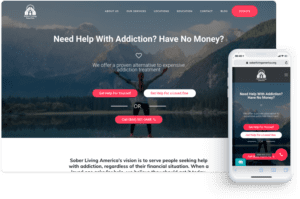We’ve seen it a thousand times. Your ad creative is impeccable, from graphic design to copywriting and CTA. Your targeting and bid strategy are on point, too. Yet your Google Ads campaign isn’t quite performing as you’d like it to. Conversions are flagging or costing you too much.
Table of Contents
What gives?
Reality check: the success of your Google Ads campaigns extend beyond the ad itself. Specifically, your landing pages play a significant role in determining Ad Quality Score, campaign performance, and costs. Let’s study Ad Quality Score a bit closer, then detail three ways you can improve landing pages for your ad campaigns.
What is Ad Quality Score?
In the Keywords section of your Google Ads account, you might have noticed the option to add “Quality Score” to your statistics table. This metric is what Google calls a “diagnostic tool,” a way to see how “relevant and useful” your ads are compared to other advertisers.
You should care about your Quality Score for two reasons:
- Your advertising costs depend on it, as Quality Score is part of the equation that determines the cost per click (CPC).
- Your Ad Rank (the position of your ad on the search engine results page) is influenced by Quality Score, thus affecting your conversion rates.
In a highly competitive digital ad space, where all advertisers have access to the same AI-powered automations (such as responsive search ads and smart bidding), a healthy Quality Score can help you extract better performance while further reducing costs.

Landing page relevancy is one of six important factors that help determine your ad quality score. The others are click-through rate, ad ranking, historical performance, copy relevancy, and keyword relevancy.
What Do Landing Pages Have to Do With Quality Score?
As with most things Google, Quality Score is algorithmic. It factors in several top-level variables into the composite score you see in your Keyword dashboard. One of the most important—and overlooked—factors is landing pages. Specifically, you’ll want to focus on three aspects of your landing pages if you want to improve your Quality Score (and overall account performance):
Landing Page Relevancy
The Google algorithm wants to show ads to users that match their intent. If your landing page does not match the search intent—if it’s generic or you’re using the same content for all keywords and ads—people don’t find what they’re looking for and bounce. In this scenario, the Google algorithm knows that your ad is not the best match for the searcher, which leads to a poor Quality Score and increased CPCs.
The most common example of relevancy mismatch we see is businesses pointing their ads to a homepage or generic services page. For example, your ad is targeted toward parents who want to get braces for their kids, but the landing page only talks about routine care and cleanings.
To ensure your landing pages match search intent, try the following:
- Build dedicated landing pages for each ad campaign
- Optimize landing pages, so they’re specific to the intent of the ad’s target keyword and audience
- Make sure the journey from search term to ad to landing page flows together
Landing Page Experience
Beyond seeing relevant content, people want a good experience when they reach a landing page. If the page doesn’t meet a person’s expectations for digital experiences—if it doesn’t render well on mobile, takes too long to load, etc.—they’ll bounce.
A high bounce rate due to poor landing page experience is yet another signal to Google that your ad wasn’t the best option to display for that keyword—and they’ll ding your Quality Score as a result. On top of relevant content, a few other ingredients go into a good landing page experience:
- Shortens the journey from click to conversion
- Follows up on “promises” made in the ad
- Speaks to user motivation and addresses barriers
- Answers important questions and creates clarity
- Creates a clear path to the conversion goal
- Loads quickly and compatibly across devices, operating systems, etc.

Landing Page Speed
While the speed of your landing pages is certainly part of the overall experience, page speed is a distinct ranking factor worthy of special consideration. People want fast websites, and the Google algorithm wants the same. A slow landing page is going to drag down your Quality Score.
The PageSpeed Insights tool will tell you an awful lot about your page speed. In 7 Essential Principles for Optimizing Your Website for Search, we recommend aiming for a score of 85 or above. To improve page speed for your ad lander, you can:
- Test using Google PageSpeed Insights, Pingdom, and other tools
- Optimize images
- Embed video (don’t self-host) and limit video ads
- Minify Javascript, HTML5, CSS, and PHP
The benefits of strong page speed go beyond quality score. To read about all of these tips for improving page speed in detail, check out 5 Tips to Increase Page Speed and Get More Traffic.
A Few Extra Tips for Your Landing Pages
We mentioned that a good landing page shortens the journey from click to conversion—that it follows up on “promises” made in the actual ad. This speaks to the broader orchestration of the click-to-conversion path that people follow. Each of these metrics—landing page experience, click-through rate, etc—will tell you when part of that path is bumpy, or that your signposts don’t quite align.
Thankfully, you can use these data points to run tests and experiences to find the optimal path for your target audience. In 5 ways to use Quality Score to improve your performance, the Google team recommends testing calls to action, headlines, and other variables on both ads and their corresponding landing pages.
Remember too that landing pages are supposed to deliver an optimal user experience that does two things:
- Increases motivation through clear value propositions, social proof, outcome statements, and practical information (payment and process, for example)
- Increase ability with elements like sticky CTA buttons, fast-loading pages, simple forms, contrasting colors, and minimal distractions
In the End, Ads Are for People First (then the Metrics)
A lot goes into your Ad Quality Score, all of it worth your close attention. When we evaluate account quality scores for our clients, we also look at expected CTR quality and ad relevance. Across all three metrics, it all boils down to people.
It’s easy to just paste in a landing page URL as a target for your campaigns. But when you stop and connect the dots between that landing page, the ad, and the person experiencing each, the word relevancy takes on new meaning. Put yourselves in your target audience’s shoes. What would you expect to see, or need, if you saw and clicked the ad?
The answer to that question is the same as the ones you’re asking about Ad Quality Score.

